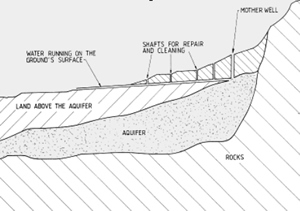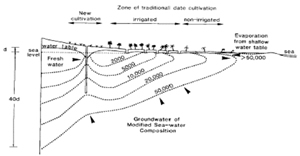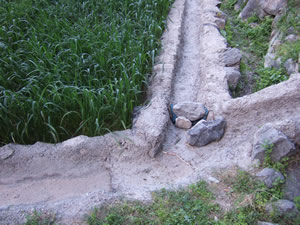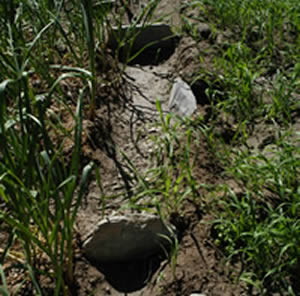About 160 000 wells and 3000 aflaj provide each about half
of the agricultural irrigation water with a growing trend for wells. Thus,
all irrigation water is groundwater, used with powered pumps (FAO 1997).
While the spring water lead by aflaj is mostly of very good quality, the
water from wells is increasingly affected by salinization. The construction
and use of wells underlie strict regulations since 1988. The traditional
irrigation technique of surface irrigation dominates, while the use of
modern irrigation technologies is growing.
The Aflaj - a traditional irrigation system in mountain oases
The traditional "aflaj" irrigation system was probably introduced
to Oman by the Persians, but may also be an own invention. It first appeared
earlier than 500 BC.
Today, of Oman’s about 4000 aflaj, about 3000 are in a healthy state,
while about 1000 have more or less dried out because of a lack of maintenance
and giving up of oases settlements and mountain agriculture.
Functioning
Rocks collect the rainfall of a large area and store it, buffering short-time
water. The size of the catchment area and the retention time of the water
determine the stability of water availability. From the aquifers at the
foot of the mountain, water is drawn and led to the settlements by canals
100m to 15km in length.
Water Distribution
In the settlement, the cleanest water is first led to a communal collection
point for drinking. Next it passes the mosque, for the ablutions and religious
washing before the prayers. After that it is free for domestic use in
the settlement, like washing, which is often done in the retention basins
called lajal. Only after running through the settlement it may be used
for irrigation.
For the distribution among farmers, a member of the community is elected.
Irrespective of his social importance, each farmer is assigned an exact
time span for irrigation, proportional to the area he owns. Water is the
limiting factor for most yields and determines which crops can be farmed
in different oases and seasons.
Sustainability
Agriculture in mountain oases in Oman has been sustainable over millennia
due to avoidance of salinization, prevention of erosion by terrace structures,
efficient and adapted water use and production for local consumption and
trade.
Modern irrigation agriculture at Batinah Plains
Near the coast are the best soils found in Oman. Silt and clay in subsurface
horizons provide a high water-holding capacity. They are most at risk
of salinization because of their fine texture.
With the economic development, the use of modern irrigation technologies was introduced in the 1970ies. In 1974, all wells were mechanized. The changes caused an extraction of groundwater exceeding natural recharge. Finally, sea water intrusion led to high concentrations of salt in the groundwater. Farming close to the coast was not possible anymore and even very salt tolerant date palms died due to water scarcity caused by the effects of salt.
To read more, please download "Irrigation and Salinisation: A Comparison of Traditional and Modern Irrigation Agriculture" by Sara Preißel and Moritz Reckling.
Continue to "The most important livestock species in Oman".

 Schematic section
of the Batinah coastal area to illustrate seawater intrusion, showing
the zone of traditional date cultivation and the newly cultivated zone.
The numbers indicate the electrical conductivity. Please klick here
to enlarge the picture.
Schematic section
of the Batinah coastal area to illustrate seawater intrusion, showing
the zone of traditional date cultivation and the newly cultivated zone.
The numbers indicate the electrical conductivity. Please klick here
to enlarge the picture.

